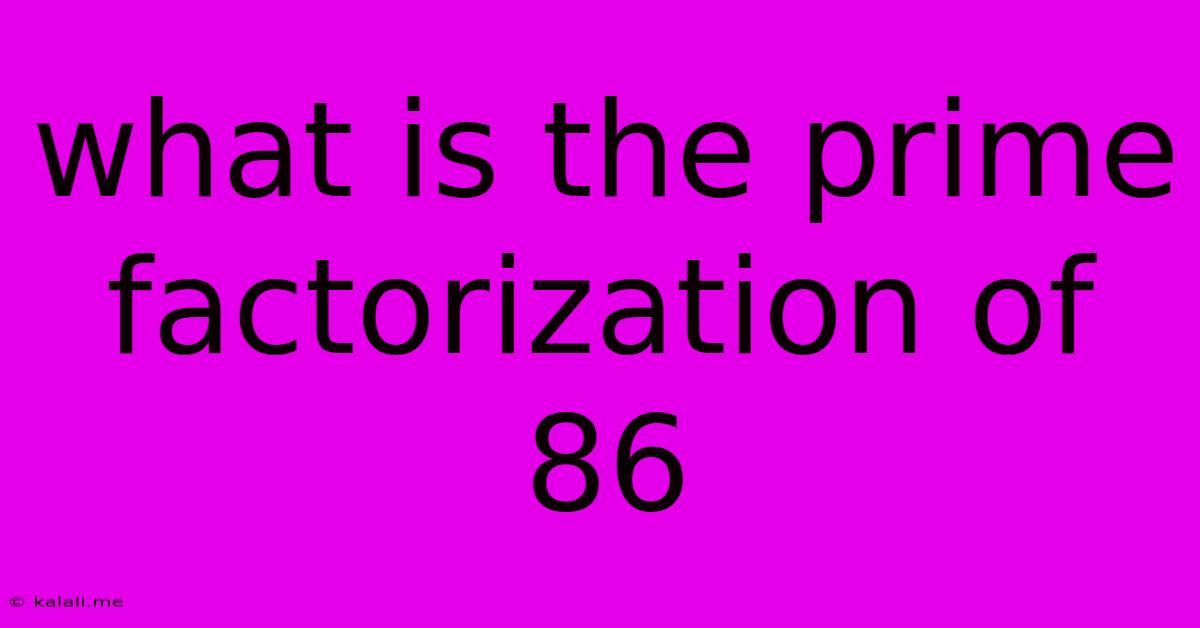What Is The Prime Factorization Of 86
Kalali
Jun 14, 2025 · 2 min read

Table of Contents
What is the Prime Factorization of 86? A Step-by-Step Guide
Finding the prime factorization of a number is a fundamental concept in number theory. This article will guide you through the process of determining the prime factorization of 86, explaining each step clearly. Understanding prime factorization is crucial for various mathematical operations and problem-solving. This guide will not only provide the answer but also equip you with the knowledge to tackle similar problems independently.
What is Prime Factorization?
Prime factorization is the process of breaking down a composite number (a number greater than 1 that is not prime) into its prime factors. A prime number is a natural number greater than 1 that has no positive divisors other than 1 and itself. The prime factorization of a number is unique; meaning there's only one way to express it as a product of primes.
Finding the Prime Factors of 86
Let's find the prime factorization of 86. We'll use a method known as the factor tree.
-
Start with the smallest prime number: The smallest prime number is 2. We check if 86 is divisible by 2. Since 86 is an even number, it is divisible by 2.
-
Divide and repeat: Dividing 86 by 2, we get 43.
-
Identify the prime factors: Now we have 2 and 43. 2 is a prime number. Let's check if 43 is also a prime number.
-
Checking for primality: 43 is only divisible by 1 and itself, making it a prime number.
Therefore, the prime factorization of 86 is 2 x 43.
Representing the Prime Factorization
We can represent the prime factorization of 86 in the following ways:
- 2 x 43 This is the simplest and most common representation.
- 2¹ x 43¹ This shows the exponents of each prime factor. This notation is particularly useful when working with larger numbers and more complex factorizations.
Applications of Prime Factorization
Prime factorization has numerous applications in mathematics and computer science, including:
- Simplifying fractions: Finding the greatest common divisor (GCD) of two numbers, often used to simplify fractions, relies on prime factorization.
- Solving Diophantine equations: Certain types of equations in number theory require prime factorization for their solutions.
- Cryptography: Prime numbers play a vital role in modern cryptography, forming the basis of many encryption algorithms.
- Modular arithmetic: Prime factorization is fundamental to various concepts within modular arithmetic.
Conclusion
By following the steps outlined above, we successfully determined that the prime factorization of 86 is 2 x 43. Understanding this process is key to grasping fundamental concepts in number theory and its various applications. Remember to always start with the smallest prime number and systematically check for divisibility until you're left with only prime numbers. Now you have the tools to confidently tackle the prime factorization of other numbers!
Latest Posts
Latest Posts
-
Hexagon Shape Objects In Real Life
Jun 14, 2025
-
What Is The Unit Weight Of Water
Jun 14, 2025
-
Example Of Solid Dissolved In Solid
Jun 14, 2025
-
Air Pressure At Sea Level Is Equal To
Jun 14, 2025
-
What Is The Opposite Of Reluctant
Jun 14, 2025
Related Post
Thank you for visiting our website which covers about What Is The Prime Factorization Of 86 . We hope the information provided has been useful to you. Feel free to contact us if you have any questions or need further assistance. See you next time and don't miss to bookmark.